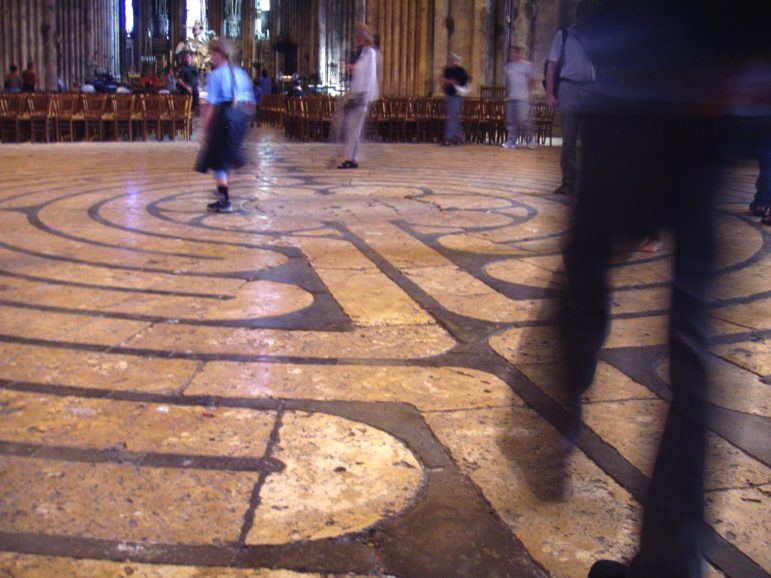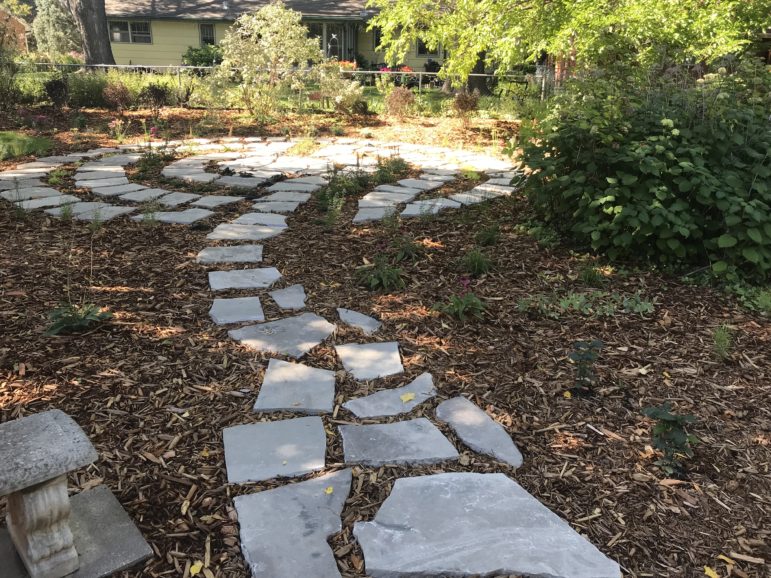
I can’t remember much about the first time I walked a labyrinth. I know that I was in seventh grade because that was when the nuns who ran Saint Mary’s of the Assumption (Govans) brought eager potential novitiates to the lush gardens at the what was then called the College of Notre Dame on North Charles Street in Baltimore. Once or twice a week in the springtime, twenty or so rambunctious seventh grade girls in plaid skirts and crisp white blouses could try to “find God” out in the grass, though some of my classmates preferred to use their time to find out the latest gossip instead. It was likely a ploy to attract future nuns; I am sure that recruitment was on the back of somebody’s mind in the order.
On one of those days, I took my favorite path through the gardens – a long, winding path composed of worn and uneven pavers. The stones were slippery from morning rain, so I pulled off my blue and white saddle shoes and limp navy socks. (We weren’t allowed to wear tennis shoes, or anything that smacked of comfort.) While most of my classmates went inside for activities with the nuns, I walked barefoot to find the deepest patch of grass: a place where I could argue with the Christian god.
In retrospect, I am shocked that nobody came after me more often. Sometimes a nun would walk down the hill and find me in my favorite spot; I remember posing with my hands folded as though in prayer, perhaps pretending to talk out loud. My goal, at first, was only to get out of going back to class, but what started as a ruse became real with time.
In my spot there was a bench next to a statue of the Virgin Mary. On that day I remember asking the Christian god why my math teacher, Sister Collette, hated that I used a pen instead of a pencil, and why Mrs. English disliked my friends. When I was older I would understand that adults think rules are important to follow, and when enough people agree on the rules and nobody challenges them, they become nearly sacred, like religious tenets. In the labyrinth, the god and I worked out my preteen angst, and I came to understand what was happening in the world around me.
I sought the refuge of the labyrinth stones many times, in sun and in rain, barefoot, with tufts of grass and hardened pebbles coarsening the soles of my feet. Looking back, I can see how those stones toughened me up, as life does to the human spirit. The labyrinth gave me respite from the hard world navigated by young people; for a time, it gave me a place to hide from my problems. I did not believe in the traditional trinitarian doctrines of the church, even as a nine-year-old, but I did believe in one-to-one communication with the divine, and this was the place I went to have that communication. It started as a place to pretend, so I could avoid going back to school, but it became a true religious outlet. It is a given now that, as a practitioner of an earth-based religion, I find something sacred in spending time in nature. Speaking with, and more importantly, listening to the gods means doing exactly as I did back in the gardens at Notre Dame.
We still visited the gardens while I attended the School Sisters of Notre Dame’s high school, but it was more rare then – perhaps one a year. High school girls got the full day press of the joys and fulfillment of religious life instead, with its promise of a community of like-minded explorers who chose to serve the Christian god together through teaching, service, and prayer. Take away the monotheism, and this sounds remarkably like a coven, lodge, kindred, or any of the other names Pagans used to describe our communities, at least to a teenager. It is humorous to think that part of my attachment to my current religious home might have come from those outings in Catholic school.
I never left the labyrinth behind after I graduated. On occasion, I would run across another one and recall the joys of being in that moment, moving deep within myself with each inward step, and putting myself back together with each step outward. In France, I had the good fortune to walk the famous labyrinths in cathedrals like Chartres. But while the largest labyrinths were in Catholic strongholds, the simplest ones made of stone found in the middle of a field were just as satisfying to walk.

Visitors walk the labyrinth inscribed in the floor of Chartres Cathedral [Daderot, Wikimedia Commons, CC 3.0
The labyrinth came roaring back into my life in 2004, at my first Pagan Pride festival. The Reclaiming Tradition had built one in front of the large eight-pillared entrance to Coffman Union at the University of Minnesota. A lovely man with a bushy beard and an afro told me the rules: Take your shoes off. Leave your bags with me – nobody will touch them. Go in with an open mind.I removed my shoes and eagerly stepped into their labyrinth, laid out in the grass near one of the largest pinwheels I had ever seen. Their labyrinth had figurines along the path that honored deities, brought back happy memories, or even commemorated dead figures outside of Pagan mythologies. I saw a tiny black statue of Elvis Presley that shook and played one of his hits – possibly Big Mama Thornton’s “Hound Dog” – and it made me laugh and want to dance. The spirit of this labyrinth combined joy, grief, longing, happiness, and communion with the gods simultaneously for me, and I loved it.
Now I wonder sometimes if I became Pagan just to come back to Pagan Pride every year to walk the Reclaiming labyrinth. Each year, the labyrinth adds something new, such as, in 2016, a tribute to the life and death of Prince that had me both crying and dancing. When the location moved to an indoor dance studio, they used straw and tiny holiday lights to set the perfect mood. If I never did anything else at Pagan Pride, I always walked the labyrinth. As a grounding tool, it was a way to release what was not needed from the previous year and to walk out with a fresh start for the year to come. As this particular Pagan Pride was always in early September, I viewed it as an early second harvest festival. While I never got into anything else that Reclaiming had to offer, I was truly grateful for the community service they provided with each labyrinth.
The most interesting labyrinth walk I have had lately was on February 18, 2020, when my employer decided to hold a “wellness day,” filled with workshops. One of the participants, a local Christian chaplain, offered an indoor cloth labyrinth as the focus of workshop entitled “Walking for Wellness and Wisdom.” It was modeled on the labyrinth in San Francisco’s Grace Cathedral, which has been on my wish list of labyrinths to visit someday.
Indigo markings traced the pattern of the labyrinth against a white backdrop on a concrete floor; in the center there was space for six people to stand in contemplation. We were advised that the cloth was fragile, and so again I found myself walking the path barefoot. While many of my co-workers carefully read documents explaining the history of labyrinths, where they were often found, and how walking the labyrinth can be found in many religious traditions around the world, I just wanted to start walking. It had been months since I felt grounded by walking through the Reclaiming labyrinth.
There were 25 participants in the workshop, so we all had to walk at a steady pace to avoid a pileup. To my surprise, many of the other walkers were members of upper management, and this let me see a different side of many whom I had only known as faces at the annual company meeting. I watched their tentative first steps along the path, their delight at reaching the center, and the reluctance to leave, and I relived all of my own early experiences in the gardens on North Charles Street.
This was my first time walking a cloth labyrinth, and I was surprised by how mellow the concrete floor felt under my feet. Occasionally the cloth covered a grate or wire unexpectedly, so I had to keep my attention on maintaining balance. I did not call to anyone in particular, but Hecate chose to speak with me about my creative life and the responsibilities that come with walking that path. This was a new experience for me, and one that helped me focus – and eventually, helped me cope with what was to come.
I did not think of that last walk as being particularly more meaningful than others, but I did think it would be an opportunity to be more public as a Pagan. Unfortunately, I never had the chance for those conversations. Less than a month later, the same people who gathered so eagerly for the wellness day were scattered by the pandemic, and we remained so for nearly 18 months. The unity we felt in walking the labyrinth together would have to sustain itself for a long time. I look back on that labyrinth now, especially after the Reclaiming labyrinth was canceled in 2020, and consider what matters about the practice.

A small garden labyrinth in the Twin Cities region [C. Ajana]
For whatever reason, the labyrinth is a key portion of my religious practice; it is a way to re-balance and to find happiness in a short period of time. I recently found a labyrinth close to my home. When I walk it, I find that each step inward reminds me of dropping what is not necessary, and that the pause in the center reminds of me of focusing on the wholeness of being, and that each step outward provides a new sense of healing and focus. It is not always required to be barefoot to walk a labyrinth, but I find I can better speak and listen to the gods when I can feel the ground beneath my feet.
THE WILD HUNT ALWAYS WELCOMES GUEST SUBMISSIONS. PLEASE SEND PITCHES TO ERIC@WILDHUNT.ORG.
THE VIEWS AND OPINIONS EXPRESSED BY OUR DIVERSE PANEL OF COLUMNISTS AND GUEST WRITERS REPRESENT THE MANY DIVERGING PERSPECTIVES HELD WITHIN THE GLOBAL PAGAN, HEATHEN AND POLYTHEIST COMMUNITIES, BUT DO NOT NECESSARILY REFLECT THE VIEWS OF THE WILD HUNT INC. OR ITS MANAGEMENT.
The Wild Hunt is not responsible for links to external content.
To join a conversation on this post:
Visit our The Wild Hunt subreddit! Point your favorite browser to https://www.reddit.com/r/The_Wild_Hunt_News/, then click “JOIN”. Make sure to click the bell, too, to be notified of new articles posted to our subreddit.